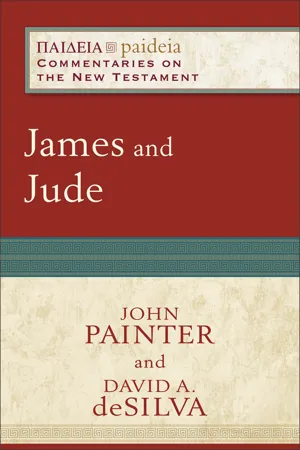![]()
James 1:1
Address/Salutation
Introductory Matters
Early in the twentieth century, Adolf Deissmann (1910, 218–46) made a distinction between the everyday letter of the Hellenistic period and the literary epistle. The absolute distinction is often blurred in reality. This is true of James and most of the Pauline Epistles. Like many everyday letters of the time, James has a standard form of address: “From A to B: Greeting.” Most ancient letters also have a closing, though the form of this is more variable. Thus, although James lacks a usual closing, it qualifies as a letter and has a suitable conclusion if not a farewell. Yet “Jacob, servant of God and the Lord Jesus Christ” is an unusual and more formal self-identification than expected in a common, everyday letter. The recipients are identified in the address “to the twelve tribes in the Diaspora.” This is no ordinary letter from one person to another. Reference to the named recipients resonates with the twelve sons of Jacob (Israel), who gave their names to the twelve tribes. The English translation of the author’s name as “James” is nowhere more unfortunate than here in 1:1. James is addressed to the children of Israel scattered throughout the Diaspora. They do not belong to an identifiable locality but rather are identified as Jews outside Judea, wherever else they may be scattered.
From the earliest references to the epistle, it was attributed to James the brother of the Lord, though its authenticity was doubted because there is little, if any, evidence of it prior to the time of Origen (see Eusebius, Hist. eccl. 2.23.24–25; see also “James and the Canon” in the introduction). This may be because the epistle was sent out in the name of James, after his death, using Jamesian tradition (see “Authorship and Origin” in the introduction).
Tracing the Train of Thought
1:1a. The epistle purports to be from Jacob (see “The Name ‘James’ or ‘Jacob’ ” in the introduction), whose name is used to identify this epistle. Unlike the Pauline Epistles (and Hebrews), which are named after their recipients, the remainder of the epistles in the NT (the Catholic Epistles) are named after their supposed authors. The name “James/Jacob” may look ordinary enough, and according to available evidence, “Jacob” was one of the ten most common Jewish names for Jewish men in Palestine at the time. As many as nine persons named “Jacob” may be referred to in the NT. Of these, only the brother of the Lord has been seriously identified as the named author. It is an irony that the Hellenized Greek form of the Hebrew/Aramaic name was translated as “James,” obscuring its relationship to Jacob, the eponymous patriarch of Israel. The Gospels identify James as the first of four brothers of Jesus (Matt. 13:55; Mark 6:3). The other three are named after the sons of Jacob. The brothers are found in the company of Jesus and his disciples during Jesus’s ministry (Matt. 12:46; Mark 3:31; Luke 8:19; John 2:12; 7:3–5; see Painter 1997a; 2004, chap. 1); they were part of the company of believers from the beginning of the early Christian movement, and James emerged as the first and preeminent leader in Jerusalem (Acts 1:14; 12:17; 15:13–21; 21:17–36). Paul describes James as “the brother of the Lord” and as the first of the three pillars of the Jerusalem church (Gal. 1:19; 2:2, 6, 9). The tradition about James collected by Eusebius adds weight to this picture of his eminence and leadership. Eusebius gathers tradition from Hegesippus, Clement of Alexandria, and Origen, who also knew the testimony of Josephus to James. (On later alternative views of the brothers, see “The Brother of the Lord and the Epistle” in the introduction.)
In this commentary, the Jacob named as author is identified as the brother of the Lord and son of Joseph and Mary subsequent to the birth of Jesus. Though James (Jacob) is named as author, there are reasons to think that this epistle embodies tradition from him but was completed and sent after his death (see Davids 1982, 12–13; for a detailed discussion of the historical James, see Painter 1997a; 2004).
The Jewish name “Jacob” reminds the reader immediately of the Jewish character of the author and of the letter he has written. The epistle uses the Hellenized form of the name (Iakōbos), not the transliteration (Iakōb), signaling the duality of its Jewish and Greek origin. The substance of the epistle comes from James the brother of the Lord, but the finished letter was published subsequent to his death and the destruction of Jerusalem in 70 CE, perhaps even subsequent to 135 CE. The Jewish name “Jacob” reflects the deeply Jewish tradition found in this letter, drawn from the Wisdom literature and the teaching of Jesus found in two strongly Jewish strands of the Jesus tradition known to us as QMt and M (see “James and the Jesus Tradition” in the introduction). The use of the Greek form of the name, Iakōbos, reflects the good mastery of the Greek language and literary conventions as well as familiarity with the language of the Greco-Roman moralists found in the letter (see “Jewish and Greek, Jerusalem and the Diaspora” in the introduction).
1:1b. Jacob identifies himself with words in this order in Greek: of God [theou] and of Lord Jesus Christ, servant [doulos]. The placement of the word “servant” at the end of the identification makes clear the inseparable connection between the two coordinates “of God and of Lord Jesus Christ.” Although both theos and kyrios are used to refer to God in the LXX, the latter has a broader range of meaning, from “sir” (in the vocative) to “master” or “Lord.” Here “Lord” refers to Jesus Christ. In James, Jesus is mentioned by name only in 1:1; 2:1. In both cases he is referred to as “Lord Jesus Christ,” once without “the” (1:1) and once with “the” and “our” (2:1 [in this case “the,” present in the Greek, is absorbed by “our” in English translation: “our Lord Jesus Christ”]).
In Greek, word order is used flexibly to convey emphasis. The first word following Jacob’s own name is “God,” the genitive case attaching the word “God” to the last word in the phrase, “servant”: “God’s servant.” The word order in Greek puts the emphasis on God. This is entirely appropriate for this epistle. Just as God (the kingdom of God) was the central message of Jesus, so God is the primary focus of the Epistle of James (Jacob). The distinctive understanding of God that emerges has deep connections with aspects of the teaching of Jesus found in strands of the Jesus tradition (see below on 1:5, 13, 17–18, 20, 27). The priority, character, and concentration of this motif in the opening and epitome imply that James’s understanding of God underlies the entire epistle.
1:1c. This understanding of God is bound up with the other defining relationship, servant of God and servant of Lord Jesus Christ. The God whom James serves is made known in the person and teaching of “Lord Jesus Christ.” The absence of the definite article (“the”) in this phrase may be intended to balance with “God,” which likewise lacks the definite article: “servant of God and Lord Jesus Christ.” Reference to Lord Jesus Christ sounds anachronistic on the lips of James of Jerusalem in 62 CE or earlier. The later the publication, the more easily we can accept the use of “Jesus Christ” as a name prefixed by “Lord.”
This is not a matter of serving two masters: “No one can serve [douleuein] two masters [dysi kyriois]; . . . You are not able to serve God and mammon” (Matt. 6:24//Luke 16:13 [Q]). Rather, the understanding of God revealed in the Jesus tradition, upon which James draws, is deeply rooted in a strand of tradition found in the Scriptures of Israel. The two sets of genitive cases define the servanthood of Jacob (“of God” and “of Lord Jesus Christ”) and are to be read as a unity. The latter clarifies the former. The understanding of God and of serving God drawn upon here is given in the teaching of Jesus.
Jesus describes his mission in terms of service. See especially Mark 10:45 in the context of 8:27–38; 9:30–37; 10:32–45. Note the synonymous parallelism of doulos in 10:44 with diakonos in 10:43, and the function of diakonēsai in 10:45. James, as the servant of Lord Jesus Christ, is the servant of the Servant of God, who is nevertheless designated Lord. James’s servanthood is defined not only by the servants of the old scriptural tradition but also by the Servant of God par excellence.
This language of servanthood overlaps the meanings of servant and slave. Nevertheless, “servant of God” describes an exalted relationship, with a rich tradition, which affirms deep devotion and obedience to God, underlying a vocation and mission of great significance. This use of the Greek doulos is embedded in the Hebrew ʿebed, which is used in the plural to describe Israel as God’s servants (Deut. 32:36) and in the singular of individuals such as Moses (1 Kings 8:53, 56), David (1 Kings 8:66), and particular prophets (Jer. 7:25; Amos 3:7). Most notably, Isaiah not only refers to Israel collectively as God’s servant (Isa. 44:1–8) but also names the role of the ideal servant of God in this way (Isa. 42:1–4; 49:1–7; 50:4–11; 52:13–53:12).
1:1d. To the twelve tribes of the Diaspora (see “Destination: The Twelve Tribes of the Diaspora” and “Jacob as Patriarch” in the introduction). Although “Jacob” was a common name, it is no ordinary name, especially when used in association with “the twelve tribes.” This association reminds the reader that the patriarch Jacob was given the name “Israel” and that the twelve tribes of Israel take their names from the twelve sons of Jacob, including the names of the three brothers of James and Jesus. The significance of the Diaspora increases following the destruction of Jerusalem in 70 CE, and even more so following the crushing of a second uprising in 135 CE. The lack of early attestation, supported by internal evidence, suggests that the epistle was circulated after James’s death (62 CE) and uses Jamesian tradition, which embodies the wisdom of Jesus. The failure of the second Jewish revolt brought an end both to Jerusalem as the Jewish capital and to the Jewish Jerusalem church. From then on, Judaism became a phenomenon of the Diaspora until the mid-twentieth century.
Figure 2. The Jewish Diaspora in the First Century CE. This map shows the wide distribution of the Jewish population throughout the Roman Empire.
The address implies an awareness of something like the ...



